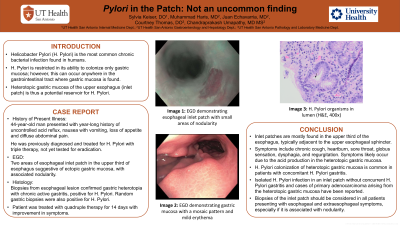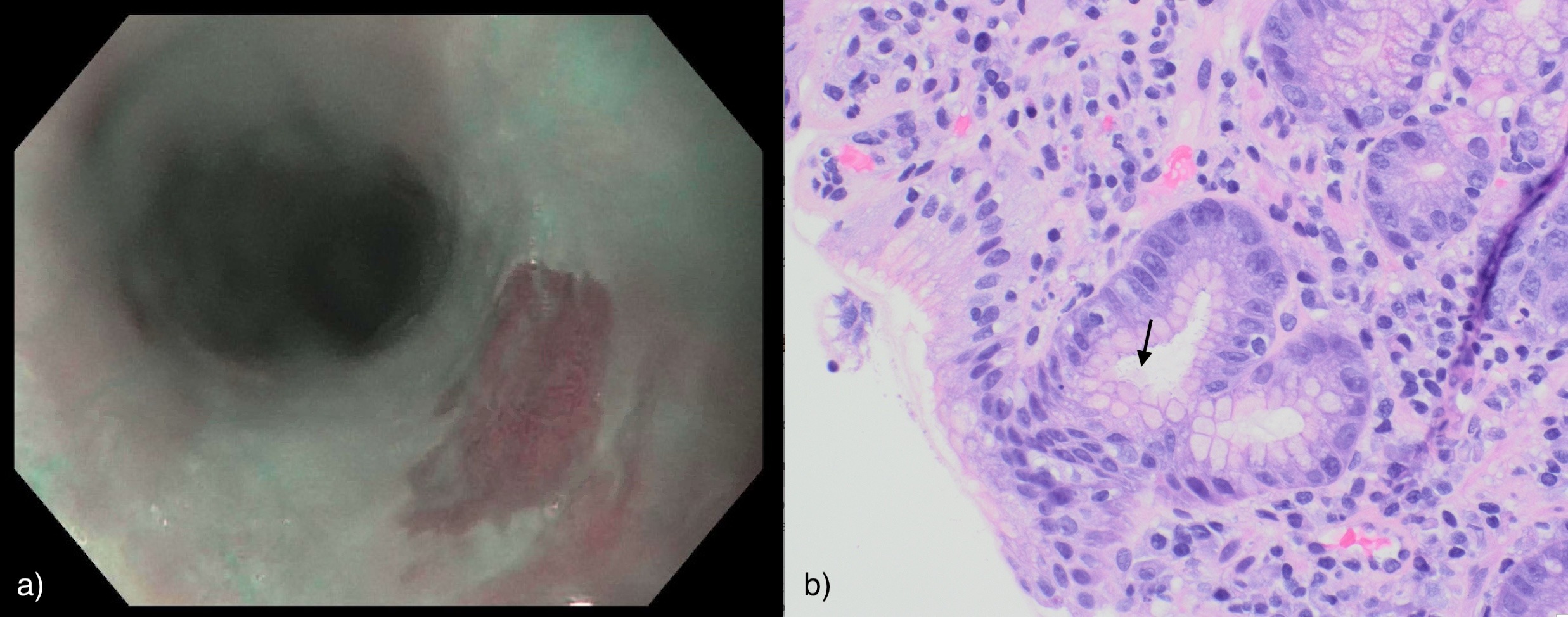Back


Poster Session B - Monday Morning
Category: Esophagus
B0228 - Pylori in the Patch
Monday, October 24, 2022
10:00 AM – 12:00 PM ET
Location: Crown Ballroom

Has Audio

Sylvia Keiser, DO
University of Texas Health San Antonio
San Antonio, TX
Presenting Author(s)
Sylvia Keiser, DO, Muhammad Haris, MD, Juan Echavarria, MS, MD, Chandraprakash Umapathy, MD
University of Texas Health San Antonio, San Antonio, TX
Introduction: Helicobacter Pylori (H. Pylori) is the most common chronic bacterial infection found in humans. H. Pylori is restricted in its ability to colonize only gastric mucosa; however, this can occur anywhere in the gastrointestinal tract where gastric mucosa is found. Heterotopic gastric mucosa of the upper esophagus (inlet patch) is thus a potential reservoir for H. Pylori. We present a case of H. Pylori infection in an inlet patch.
Case Description/Methods: A 44-year-old Hispanic male presented to the gastroenterology clinic for chronic dyspepsia. The patient endorsed a year-long history of uncontrolled acid reflux, nausea with vomiting, loss of appetite and diffuse abdominal pain. He reported being diagnosed with H. Pylori infection through a stool test performed 3 months prior to the visit. He completed treatment with amoxicillin, clarithromycin, and pantoprazole, but had not yet been tested for eradication. The patient underwent an esophagogastroduodenoscopy (EGD) that revealed two areas of esophageal inlet patch in the upper third of the esophagus suggestive of ectopic gastric mucosa, with associated nodularity. The biopsy from the esophageal lesion confirmed gastric heterotopia with chronic active gastritis and a positive hematoxylin and eosin (H&E) stain for H. Pylori. Random gastric biopsies were also positive for H. Pylori. The patient was treated with quadruple therapy (pantoprazole, bismuth, metronidazole, and tetracycline) for 14 days with subsequent improvement of his symptoms during follow up visit.
Discussion: Inlet patches are mostly found in the upper third of the esophagus, typically adjacent to the upper esophageal sphincter. Clinical symptoms of inlet patches can include chronic cough, heartburn, sore throat, globus sensation, dysphagia, and regurgitation. These symptoms likely occur due to the acid production in the heterotopic gastric mucosa. The incidence of H. Pylori in a patch has been found to closely correlate with the density of the bacteria in the stomach. However, H. Pylori colonization of heterotopic gastric mucosa is not seen in all cases of H. Pylori gastritis, which points towards reflux as the inciting event. Isolated H. Pylori infection in an inlet patch without concurrent H. Pylori gastritis and cases of primary adenocarcinoma arising from the heterotopic gastric mucosa have been reported. Biopsies of the inlet patch should be considered in all patients presenting with esophageal and extraesophageal symptoms, especially if it is associated with nodularity.

Disclosures:
Sylvia Keiser, DO, Muhammad Haris, MD, Juan Echavarria, MS, MD, Chandraprakash Umapathy, MD. B0228 - Pylori in the Patch, ACG 2022 Annual Scientific Meeting Abstracts. Charlotte, NC: American College of Gastroenterology.
University of Texas Health San Antonio, San Antonio, TX
Introduction: Helicobacter Pylori (H. Pylori) is the most common chronic bacterial infection found in humans. H. Pylori is restricted in its ability to colonize only gastric mucosa; however, this can occur anywhere in the gastrointestinal tract where gastric mucosa is found. Heterotopic gastric mucosa of the upper esophagus (inlet patch) is thus a potential reservoir for H. Pylori. We present a case of H. Pylori infection in an inlet patch.
Case Description/Methods: A 44-year-old Hispanic male presented to the gastroenterology clinic for chronic dyspepsia. The patient endorsed a year-long history of uncontrolled acid reflux, nausea with vomiting, loss of appetite and diffuse abdominal pain. He reported being diagnosed with H. Pylori infection through a stool test performed 3 months prior to the visit. He completed treatment with amoxicillin, clarithromycin, and pantoprazole, but had not yet been tested for eradication. The patient underwent an esophagogastroduodenoscopy (EGD) that revealed two areas of esophageal inlet patch in the upper third of the esophagus suggestive of ectopic gastric mucosa, with associated nodularity. The biopsy from the esophageal lesion confirmed gastric heterotopia with chronic active gastritis and a positive hematoxylin and eosin (H&E) stain for H. Pylori. Random gastric biopsies were also positive for H. Pylori. The patient was treated with quadruple therapy (pantoprazole, bismuth, metronidazole, and tetracycline) for 14 days with subsequent improvement of his symptoms during follow up visit.
Discussion: Inlet patches are mostly found in the upper third of the esophagus, typically adjacent to the upper esophageal sphincter. Clinical symptoms of inlet patches can include chronic cough, heartburn, sore throat, globus sensation, dysphagia, and regurgitation. These symptoms likely occur due to the acid production in the heterotopic gastric mucosa. The incidence of H. Pylori in a patch has been found to closely correlate with the density of the bacteria in the stomach. However, H. Pylori colonization of heterotopic gastric mucosa is not seen in all cases of H. Pylori gastritis, which points towards reflux as the inciting event. Isolated H. Pylori infection in an inlet patch without concurrent H. Pylori gastritis and cases of primary adenocarcinoma arising from the heterotopic gastric mucosa have been reported. Biopsies of the inlet patch should be considered in all patients presenting with esophageal and extraesophageal symptoms, especially if it is associated with nodularity.

Figure: a) Endoscopy demonstrating esophageal inlet patch with increased nodularity
b) Helicobacter Pylori organisms in lumen (H&E, 400x)
b) Helicobacter Pylori organisms in lumen (H&E, 400x)
Disclosures:
Sylvia Keiser indicated no relevant financial relationships.
Muhammad Haris indicated no relevant financial relationships.
Juan Echavarria indicated no relevant financial relationships.
Chandraprakash Umapathy indicated no relevant financial relationships.
Sylvia Keiser, DO, Muhammad Haris, MD, Juan Echavarria, MS, MD, Chandraprakash Umapathy, MD. B0228 - Pylori in the Patch, ACG 2022 Annual Scientific Meeting Abstracts. Charlotte, NC: American College of Gastroenterology.
